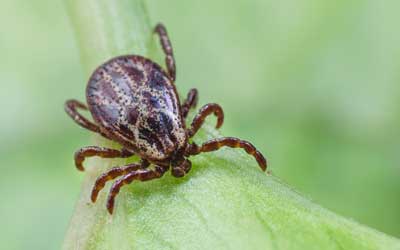Ticks come out again every spring and summer to look for animals to feed on. Their diets can range from birds, to deers, to rodents and other small mammals, but unfortunately, also extend to us and our pets. These sneaky pests are not just a nuisance, they are also capable of causing serious illnesses, including the daunting Lyme disease. To prepare yourself for the height of tick season, you can learn about the types of ticks in your area and the best actions to take once you’ve been bitten.
What Types of Ticks Live in Vermont?
There are several species of ticks living in our area, but three of them stand out as the most prominent:
- Lone star tick: With their elongated mouthparts and characteristic white spot on their back, the lone star tick is easily identifiable. You’ll often find them in wooded areas where lots of small animals live.
- American dog tick: These ticks have a very similar anatomy to the lone star tick, but are more reddish-brown in color and have smaller mouthparts. American dog ticks’ common targets are, you guessed it, dogs. This doesn’t stop them from going after humans, though!
- Deer tick: The deer tick is widely feared for its ability to transmit the bacteria that causes Lyme disease. They are smaller and darker in color than the previously mentioned ticks, making them hard to spot.
Although you can only contract Lyme disease from a deer tick bite, each one of these tick species has been known to carry several kinds of dangerous diseases.
How to Remove a Tick Safely
It’s important to remove ticks from your skin as soon as you notice them to avoid contracting a disease. The CDC has laid out these steps for safe tick removal:
- Pinch the tick closely to the surface of the skin using a pair of tweezers.
- Pull the tick out of the skin with a slow and steady motion. Twisting the tweezers while pulling could cause the tick’s mouthparts to break off in your skin. If this happens, you can use the tweezers to take them out afterward.
- After removing the tick, clean the area of the bite with rubbing alcohol or soap and warm water.
- Get rid of the tick by flushing it down the toilet, throwing it away in a sealed trash can, or putting it in alcohol. Do not use your bare hands to squish it.
You can decrease your chances of developing an illness by removing ticks from your skin as soon as possible. If you start to notice signs of a fever or a rash within 2-3 weeks of a recent tick bite, talk to a medical professional about your symptoms.
Tick Extermination Services in Vermont
If you’re already noticing a heightened population of ticks near your home or around your property, ask your local pest control company about what they can do. The tick experts at Vermont Pest Control have years of experience dealing with all kinds of ticks in our region. Contact us today to find out how we can help you get rid of your tick problem!

